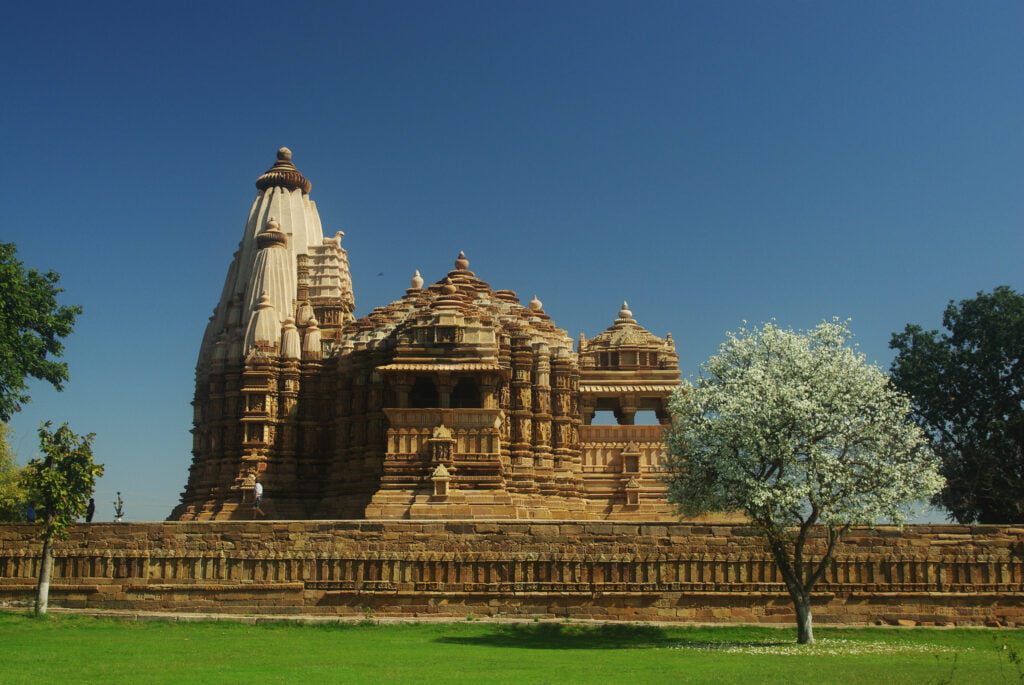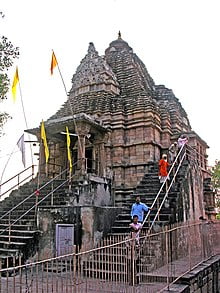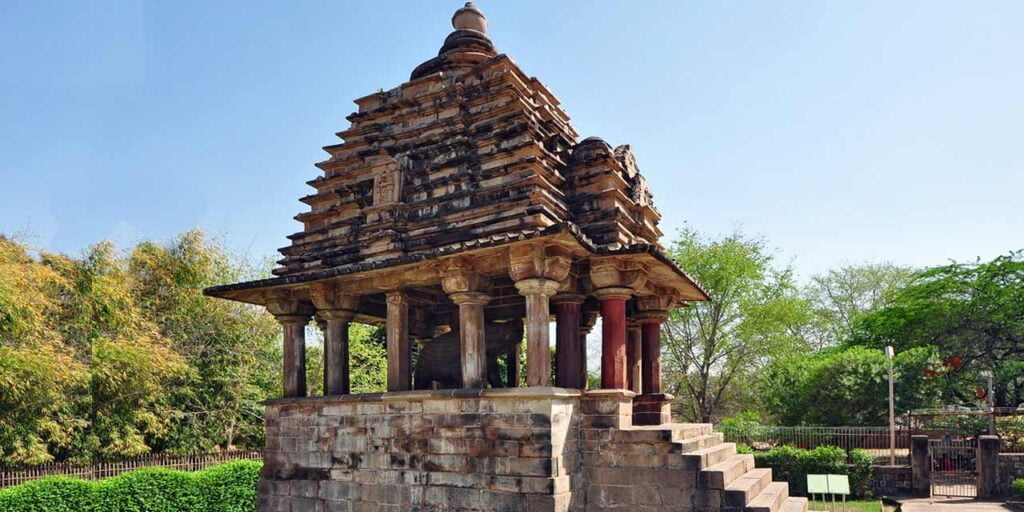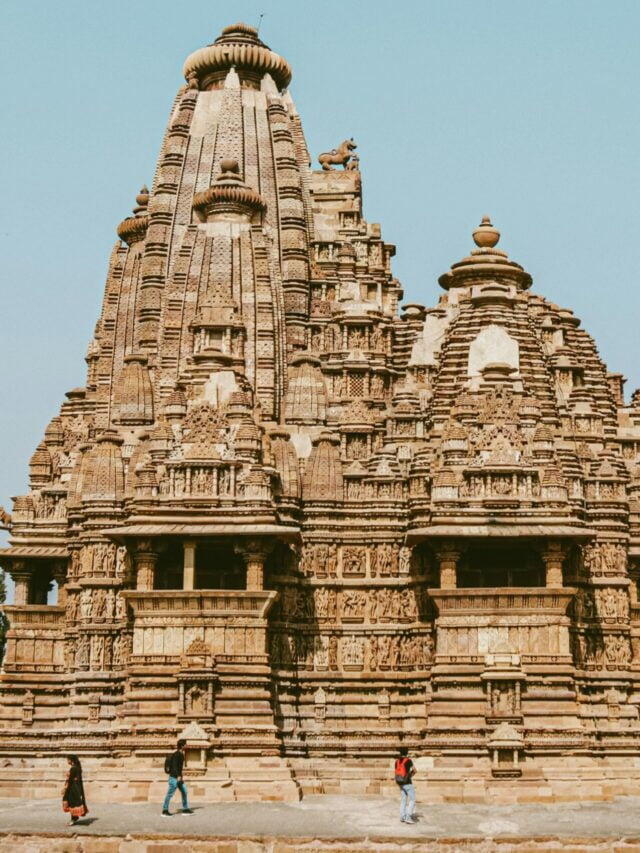Introduction
One example of India’s rich cultural and architectural legacy is the Temple of Khajuraho. This magnificent temple complex, located in the center of Madhya Pradesh, has a long history dating back to the tenth and eleventh centuries. Of the approximately eighty-five temples that once made up this cluster, only about twenty of these amazing buildings still stand today. Khajuraho is recognized as a World Heritage Site by UNESCO, a designation well-earned by the remaining temples, renowned for their elaborate and beautiful carvings.
Temple of Khajuraho is more than just a group of historic buildings; it offers a glimpse into the colorful past of medieval India. The depth and complexity of ancient Indian culture is showcased by these temples, which are famous for their architectural genius as well as their explicit portrayals of ordinary situations, human emotions, and celestial creatures. Not only are the sculptures and carvings on the temple walls works of art, but they also tell stories about religious rituals, social mores, and historical attitudes.
The Temple of Khajuraho is an immersive experience that is just waiting to be discovered, not merely an architectural wonder. Every feature of the complex, from the opulence of its buildings to the exquisite embellishments set into the stone, invites guests to explore the intricate web of artistic and historical richness. One can learn a wealth of historical information by exploring the stories woven into the walls of this ancient temple. These narratives tell of tales of devotion, mythology, and the cultural fabric that distinguishes India.
Unraveling the History of Temple of Khajuraho
By providing a glimpse into the rich past and creative majesty of the Temple of Khajuraho, in this section we provide a fuller understanding of the historical background, cultural relevance, and architectural brilliance that define the temple.
History and Establishment of the Temple
During the 10th and 12th centuries, the Chandela dynasty controlled central India, and this is where the Temple of Khajuraho got its start. The building of these temples is thought to have started in 950 AD, during the time of the Chandela kings, according to historians. Although the precise motivation for the creation is still up for discussion, it is generally accepted that these temples were built in honor of several Hindu deities, such as Shiva, Vishnu, and others.
The Construction’s Cultural and Historical Context
The building of the Khajuraho temples coincided with an era of artistic, cultural, and religious development in India. It was a period of comparatively good peace and prosperity, which created an atmosphere that was favorable to creative pursuits. The temples, which were surrounded by lush vegetation, were not only locations of prayer but also hubs for spiritual and cultural pursuits that drew pilgrims, intellectuals, and artists from all over the world.
The Significance of Architectural Magnificence in Indian Traditions
Famous for its architectural genius, the Temple of Khajuraho complex is distinguished by its exquisite sculptures and distinctive fusion of architectural styles. The temples exhibit the Nagara architectural style, which is distinguished by tall, ornately carved towers known as “shikhara.” The detailed and realistic portrayal of human shapes and activities in Khajuraho exhibits a level of artistic skill that is seldom found in other places.
This is an important location in Indian history because of its rich tapestry of religious, historical, and cultural narratives carved into its walls in addition to its impressive architectural design. Its ageless beauty and historical significance continue to enthrall visitors, serving as a monument to the artistic prowess of ancient India.
Understanding the Architecture
In this section we try to show the importance of the Temple of Khajuraho’s artistic aspects by delving into the intricate architectural details, the layout, and the profound meaning inherent in the carvings and sculptures.
Overview of the Architecture and Layout of the Temple
The Western, Eastern, and Southern groups of temples make comprise the primary structure of the fascinating Temple of Khajuraho complex. These temples, each with a distinct layout and purpose, are placed thoughtfully inside gated enclosures. The most well-known temples of the Western group serve as a reminder of the opulence of the period’s architecture. Each temple has its own shrine, mandapa (hall), and elaborate exterior walls decorated with sculptures, demonstrating a well-organized plan.
Thorough Examination of Architectural Elements
The most remarkable feature of Khajuraho is the quality of its sculptures and carvings on the walls of the temple. These elaborate carvings show a variety of facets of life, from celestial nymphs and divine creatures to regular scenes of musicians, dancers, and craftspeople. The statues exhibit an amazing mastery of artistry and craftsmanship due to their painstaking detail-oriented sculpting. The temples have a variety of architectural elements, such as elaborately carved and sculptured shikhara (towers), mandapas (halls), and exquisite entrance gates.
Importance of the Carvings’ Symbolism and Detailed Details
In addition to being aesthetically pleasing, the carvings at Khajuraho have significant symbolic meaning. The fine details, which include gods, goddesses, celestial beings, and scenes from epics like the Ramayana and Mahabharata, tell stories from Hindu mythology. Furthermore, the concepts of love, devotion, and spiritual enlightenment are frequently represented by these carvings. Despite their contentious nature, the sensual sculptures are thought to represent the unity of the material and spiritual worlds and highlight the holiness of all facets of existence.
These sculptures’ symbolism, which depicts the dominant religious, cultural, and philosophical ideas of the time, acts as a visual language. Every motif and sculpture is a work of art that tells tales and makes important statements while providing an insight into the social and spiritual ethos.
Mysteries and Legends Surrounding Khajuraho
The purpose of this part is to explore the fascinating legends, enigmas, and timeless folklore surrounding the Temple of Khajuraho, enhancing its historical significance and attraction.
Legendary Stories Associated with the Temple of Khajuraho
Rich in engrossing legendary stories that heighten the place’s already mysterious aura. According to a narrative, the Pandava brothers from the Mahabharata epic are credited with building the temples when they were in exile. According to another account, a young Brahmin who underwent intense penance was bestowed with heavenly powers by the gods, which enabled him to construct these magnificent temples.
Revealing the Mysteries Around a Few Carvings and Images
Some secrets and mysterious representations among the elaborate carvings and sculptures have fascinated visitors and scholars alike. Certain carvings show minute elements of daily life, yoga poses, and celestial beings whose meaning isn’t immediately clear. There are still disagreements among historians and archaeologists over the exact meanings carved onto these monuments.
In addition, there has been discussion and interest generated by the temple walls’ portrayal of eroticism. According to some interpretations, these sculptures celebrate fertility and the circle of life or depict the quest for heavenly connection. Though it’s unclear exactly what the purpose of these overt sculptures is, they encourage reflection and differing interpretations.
Common Stories and Beliefs Transmission Across Generations
Generations of people have passed down legends and beliefs about Khajuraho, which has added to its mystique and attraction. Tales of secret passageways, hidden rooms within temples, and hidden wealth waiting to be found are frequently told in local folklore. Even though a lot of these tales are rooted in folklore, they add to the mystique and awe that permeate the temple complex.
Khajuraho’s eternal charm is not limited to its architectural grandeur; it also includes the enigmatic stories and mysterious features that captivate tourists’ thoughts and arouse a timeless curiosity.
Exploring the Twelve Marvels Within the Temple
In order to improve understanding and appreciation, in this part we will examine the twelve most noteworthy aspects of the Temple of Khajuraho in detail, providing stories and insights into their significance. Additionally, visual aids will be taken into consideration.

Summaries of the Temple of Khajuraho’s Twelve Most Notable Features
Temple of Kandariya Mahadeva:
The Kandariya Mahadeva Temple, the tallest and most magnificent temple, is a masterwork of artistic and architectural design.
At the pinnacle of cosmic spirituality is its towering spire, which is covered with elaborate carvings of gods, goddesses, and heavenly creatures. There is an amazing synergy between the worlds of the gods and humans as the walls tell stories of divine creation, celestial festivals, and the perpetual dance of the gods.

Lakshmana Temple:
Honoring Lord Vishnu, this temple captivates with its finely carved representations of episodes from the epic Ramayana. The intricate story, which depicts events like Lord Rama’s coronation and the fight between Rama and Ravana, is painted on the temple walls. It displays dedication, bravery, and the victory of righteousness.

Devi Jagadambi Temple:
Honoring the feminine divine, this temple enthralls visitors with its representations of numerous goddesses and feminine deities. The exquisite sculptures honor the many facets of women and represent the divine feminine essence by radiating grace, strength, and maternal love.

Chitragupta Temple:
Honoring Surya, the sun deity, this temple is beautifully carved to depict Surya’s celestial chariot pulled by seven horses, with its twelve wheels signifying the seasons. The minute details perfectly convey Surya’s brilliance and importance in Hindu mythology.

Vishvanatha Temple:
Honoring Lord Shiva, this temple features a variety of carvings depicting events from Shiva’s life, such as his cosmic dance, the Tandava. The statues, which depict Shiva’s cosmic function as creator, preserver, and destroyer, encapsulate the essence of deity.

Duladeo Temple:
Dedicated to Lord Shiva, the temple’s elaborate carvings show mythological tales and divine couples dancing in the sky. The intricate workmanship captures the essence of spiritual connection and divine love with devotion and elegance.

Matangeshvara Temple:
Still an active place of worship for Lord Shiva, the Matangeshvara Temple is home to a towering lingam. The temple’s holiness and tranquility foster an atmosphere of spiritual reverence and devotion, drawing pilgrims and devotees looking for consolation and blessings.

Varaha Temple:
This temple honors Lord Vishnu in his Varaha incarnation and is well-known for its enormous Varaha sculpture, which shows Vishnu saving the earth goddess while he is shaped like a pig, signifying the victory of good over evil.

Chaturbhuj Temple:
Despite its incompleteness, the Chaturbhuj Temple is a remarkable example of architecture. Its massive structure and elaborate carvings provide hints of the intended splendor, inspiring awe for the era’s artistry.

Jagadambi Temple:
The statues of female deities at the Jagadambi Temple, which radiate grace and elegance, represent the divine feminine in all of her manifestations, displaying compassion, strength, and beauty.

Parshvanatha Temple:
This temple, which honors the Jain tirthankara Parshvanatha, is distinguished for its finely carved columns and sculptures that depict Jain mythology and philosophy. The calm environment encourages introspection and spiritual contemplation.

Adinatha Temple:
Adorned with exquisite carvings of mythological and Jain icons, the Adinatha Temple is a tribute to the artistic talent and cultural diversity of its era. It embraces the magnificence of Jain architecture.
The Stories and Significance of Each Marvel
These marvels each contain their own stories, religious meanings, and cultural symbols. The carvings and sculptures portray stories from Hindu epics, highlight the attributes of gods, and represent spiritual ideas, providing an insight into past customs and beliefs. The temples serve as living archives of the period’s mix of cultures, artistic talent, and spiritual commitment.
Preservation Efforts and Challenges
The purpose of this part is to provide light on the Temple of Khajuraho’s preservation efforts, difficulties encountered, and worldwide relevance of doing so. It also emphasizes the need of community involvement and cooperative action.
Measures Made to Preserve the Temple:
Conservation Programs: Large-scale conservation initiatives have been launched by a number of governmental and non-governmental organizations to preserve the Khajuraho temples’ historical relevance and structural integrity. The restoration, structural stability, and environmental deterioration prevention of the delicate carvings are the main objectives of these activities.
Research and Documentation: In order to comprehend the architectural styles, historical background, and preservation requirements of the temple complex, a great deal of research and documentation has been done. This entails conducting thorough assessments, recording carvings, and creating preservation strategies.
Education and Awareness: There have been continuous initiatives to increase public understanding of the value of cultural heritage and the necessity of protecting historic sites like Khajuraho. The goals of outreach initiatives, guided tours, and educational programs are to inspire tourists, residents, and students to value and safeguard these treasures.
Difficulties in Keeping Up the Historical Site
Environmental variables: Weathering, erosion, humidity, and pollution are some of the environmental variables that pose a threat to the temples. The aforementioned issues present notable obstacles to the preservation endeavors by contributing to the slow deterioration of the stone carvings and structural integrity.
Impact of it: Although it helps the area become more well-known and economically developed, it also brings with it certain difficulties. Wear and tear on the structures can be accelerated by increased foot traffic, poor visitor management, and poor upkeep as a result of a large influx of tourists.
Resource Constraints: The implementation of comprehensive preservation measures is hindered by limited financial resources, labor, and conservation experience. The difficulty of balancing conservation needs with finite resources never goes away.
Participation of the Community and the Worldwide Importance of Preservation
Community Involvement: The preservation of the temples is greatly aided by the local community. Engaging locals in conservation initiatives fosters a feeling of community and provides prospects for sustainable tourism and economic development.
Global Significance: Khajuraho’s preservation is important for the common heritage of humanity as a whole, not just for India. The preservation of these temples is a global duty since they serve as a witness to the artistic, architectural, and cultural achievements of past civilizations.
Collaborative Efforts: A collaborative approach to preservation is being fostered by partnerships between government agencies, heritage organizations, academic institutions, and international authorities. The combined knowledge, experience, and resources of these endeavors are intended to guarantee Khajuraho’s long-term preservation.
To protect this priceless legacy for future generations, the Temple of Khajuraho needs to be preserved using a multifaceted strategy that includes conservation, education, community involvement, and sustainable tourism.
Experiencing Khajuraho: A Visitor’s Guide
This extensive part intends to help travelers plan their trip to the Temple of Khajuraho by providing useful advice, and insights into the ideal times to visit, and emphasizing the importance of first-hand experiences within the temple complex for both cultural and educational purposes.
Advice for Visitors:
Consider to take the guided tours offered by knowledgeable guides while visiting the Temple of Khajuraho. These guides improve visitors’ comprehension and appreciation of the temples by providing cultural context, deciphering the complex carvings, and providing in-depth historical insights.
Proper Clothes: When visiting places of worship, wear clothing that shows respect. Choose attire that covers your knees and shoulders as a sign of respect for the location’s holiness.
Photographic Etiquette: Observe the temple’s photography policies. Some locations may forbid photography as a sign of reverence for the site’s sacredness. Remember these rules.
Extensive Inspection: Give each temple a thorough inspection. others smaller temples may be more peaceful and absorbing than others, even though others may see a higher volume of visitors.
The Best Times to Go and What to Expect From Temple of Khajuraho:
Weather-related factors: The winter months of October through March are the best times to visit Khajuraho because of the excellent weather that makes for exploration.
Seasons of Festivals: Make travel plans during festival seasons to experience the February Khajuraho Dance Festival. Experience the captivating spectacle of classical dance performances set against the backdrop of lit temples during this event.
Expected Experience: The Temple of Khajuraho’s intricate sculptures and majestic architecture are sure to enthrall visitors. The calm atmosphere evokes a sense of spirituality and takes people back to a time when culture was extremely rich.
The Temple of Khajuraho’s Cultural and Educational Significance:
A personal exploration of the Temple of Khajuraho reveals a wealth of historical information. A visual history of ancient Indian culture, customs, and social mores is shown through the stunning carvings and sculptures.
Spiritual Connection: As they go around the temple complex, visitors frequently experience a strong spiritual connection. A sense of inner serenity and a connection to the divine are fostered by the tranquillity and reverent atmosphere.
Educational Significance: The Temple of Khajuraho visit provides an intensive educational trip into India’s past for enthusiasts and students alike. It functions as a living classroom, exhibiting the wonders of architecture and offering insights into religious rituals, artistic expression, and ancient culture.
A trip to the Temple of Khajuraho is more than just a sightseeing expedition; it’s an enlightening voyage through culture and history. It imprints each visitor with a lasting impression by fusing spirituality, art, history, and education.
Khajuraho Beyond the Temple
The purpose of this part is to provide information on the Temple of Khajuraho’s cultural offerings, extracurricular activities, and role in forming Khajuraho’s identity in addition to its architectural legacy.
Village and Cultural Offerings Examination
Temple of Khajuraho is home to a plethora of lively local marketplaces where tourists may peruse and buy gorgeous handwoven fabrics, intricately crafted sculptures, traditional handicrafts, and other locally manufactured goods. These markets offer an insight into the creative history of the area.
Cultural Shows & Performances: Classical Indian music, dance, and folk arts are on display at Khajuraho, which is located outside the temple complex. These occasions frequently showcase the area’s rich cultural legacy while enthralling guests with their superior artistic quality.
Additional Tourist Attractions in Khajuraho
Panna National Park: Known for its diverse wildlife, which includes tigers, leopards, and rare kinds of flora and fauna, nature enthusiasts can visit the neighboring Panna National Park. Safari tours provide an opportunity to experience the area’s natural splendor.
Raneh Falls and Ken Gharial Sanctuary: These two natural landmarks, which are close to Temple of Khajuraho, draw visitors with their stunning scenery. The Raneh Falls is home to gharials, or Indian crocodiles, in their native environment.
archeological Museum: Visitors can gain a deeper insight of the history and artistic legacy of the area by perusing the Archaeological Museum of Khajuraho, which is a veritable gold mine of antiquated objects, sculptures, and archeological discoveries.
The Temple’s Significance to the Town’s Character
Cultural Magnet: The main attraction for tourists from all over the world is the Temple of Khajuraho. Khajuraho has become an internationally recognized cultural destination due to its remarkable architecture and historical significance.
Economic Impact: The town’s economy benefits greatly from the Temple of Khajuraho complex’s tourism industry. Many locals rely on the flood of tourists to support their businesses, hotels, restaurants, and artists, as well as their way of life.
Cultural Heritage: The residents’ feeling of pride and identity has been deeply embedded by the Temple of Khajuraho complex. It fosters a strong link to the town’s cultural roots by serving as a symbol of the town’s heritage and historical legacy.
Beyond just being an architectural wonder, the Temple of Khajuraho is more than just a historical landmark; it is the cultural centre of the town, shaping its identity, commerce, and liveliness. Beyond the temple itself, the surrounding attractions provide visitors with a varied experience.
Conclusion
The Temple of Khajuraho is a magnificent example of India’s mastery of architecture and artistic design. The temple complex’s twelve outstanding features, each a unique masterpiece, capture the depths of ancient Indian civilization. They reveal elaborate carvings, spiritual tales, and architectural brilliance, providing a window into the opulence of a bygone period.
The Temple of Khajuraho is more than just a building made of stone and mortar; it is the essence of India’s cultural legacy. Its ageless beauty, which is embodied in magnificent sculptures and architectural wonders, is the pinnacle of creative success and spiritual expression. This cultural treasure resonates with the spirit of India’s rich and varied past, acting as a link between the past and present.
Historical treasures like the Temple of Khajuraho must be treasured and preserved as stewards of our common history. By means of investigation and admiration, we pay tribute to the skill, knowledge, and customs of our predecessors. Every visit to one of these locations offers the chance to observe not just architectural wonders but also historical connections that deepen our comprehension of humanity’s evolutionary history.
Discovering historical wonders like Temple of Khajuraho is a celebration of human ingenuity, resiliency, and the everlasting spirit of cultural legacy—it’s more than just a trip through time. Let’s keep discovering, appreciating, and protecting these riches for future generations.






